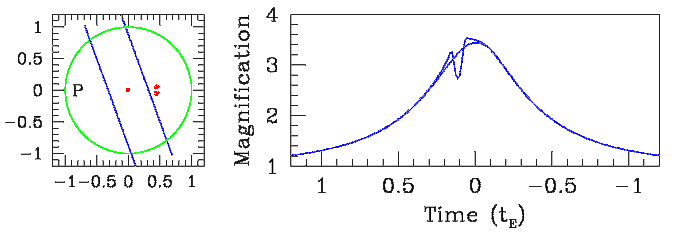
The most numerous stars in the Milky Way are M dwarfs, cool stars that are somewhat dimmer and smaller than our own Sun. M dwarfs are therefore the most common type of Galactic microlens, making their presence known by the gravitational ``twinkling'' effect that they have on distant background stars directly behind them. Generally, the smooth gravitational field of the microlens causes a gentle rise and then decline in the brightness of the background object. Hundreds of such single microlensing events have been observed toward the center of our Milky Way galaxy. Planets orbiting the microlens will distort its gravitational field, creating anomalies (wiggles) in the light curve of the background object. If such a planet were as massive as our own Jupiter, orbiting a microlens at distances typical of the orbits of Mars or Jupiter, these wiggles should often be visible in the microlensing observations of the worldwide PLANET collaboration. Nevertheless, in five years of monitoring, the PLANET team has discovered no signs of a planetary wiggle in 43 high-quality light curves. This lack of detections leads to the conclusion no more than 1/3 of all M dwarf stars could have a Jupiter-mass companion orbiting at 1.5 to 4 AU. (1 AU is the distance at which the Earth orbits our Sun.)

Even if all stellar lenses had such planets, many would be missed. Whether or not a planet leaves its mark in an observed microlensing light curve depends on the path of the background star behind the magnification pattern of the lens+planet. In the panel above, the figure on the left shows a view of the sky with two possible paths for the background star drawn in blue. (The diameter of the green circle represents a portion of the sky about 1 one-thousand of an arcsecond across, or about the size of a person as seen from the Moon.) The lens is located in the center, and the hypothetical planet position is marked with a ``P''. The positions of the strongest distortions caused by the planet+lens combination are marked in red. The figure on the right shows the light curve (brightness measured over time) for both of these possible paths for the background star. Only one light curve shows the wiggles that betray the presence of the invisible planet. The other looks normal, because the star did not pass near the disturbed portion of the lens magnification pattern.
But if such planets are numerous, eventually some will produce characteristic wiggles in microlensing light curves. Careful monitoring by the PLANET team of 43 microlensing events has revealed no planetary signatures. These results can be used to place constraints (upper limits) on the fraction of microlenses that can have certain types of planets orbiting them. Since microlensing is currently most sensitive to planets near Jupiter's mass displaced a few AU on the sky from its parent star, the constraints are strongest for this type of planet.
The maximum fraction of microlenses that can have a particular type of planet
is indicated with colors in the figure below:
RED = 1/4,
BLUE = 1/3,
GREEN = 1/2,
CYAN = 2/3.
In this figure, q is the ratio between
the planet and parent star mass, and d is the distance that they are separated
compared to the Einstein ring radius. (The Einstein ring is the green circle
in the first picture.) For example, according to the PLANET team results,
at most 1/4 of all microlenses can have a planet with 0.003 (0.3%) the mass of
its parent star at a projected separation equal to one Einstein ring radius.
For the M dwarf stars in the inner part of our own Galaxy
that are the most typical microlenses, such planets have the masses similar
to our own Jupiter, and orbits similar to those of Mars or Jupiter. The PLANET
results show that most M dwarfs in our Galaxy, 2/3 to 3/4 of them in fact, do not
have this type of planetary companion.

The Doppler shift (or radial velocity) method has found several planets around nearby star, including the first confirmed extrasolar planet. The lack of planet discoveries by the PLANET team using microlensing are not in conflict with the Doppler results because the two techniques are sensitive to different kinds of planets. The Doppler-discovered planets are massive planets orbiting close to their parent star, using within 2 AU, as can be seen in this plot of known extrasolar planets (courtesy http://exoplanets.org).
Thus the Doppler technique is finding planets quite unlike any in our own Solar System, namely: massive planets of about Jupiter's mass around stars similar to our Sun, but orbiting at distances smaller than the orbits Mars (or even Mercury!). These planets orbit too close to their parent stars to be seen easily by microlensing. On the other hand, the Doppler technique searches are not currently capable of detecting planets like our own Jupiter, which orbits our own Sun at 5.2 AU. Do such planets exist? The microlensing results of the PLANET team indicate that at least the most common stars in our Galaxy, M dwarfs with about 1/3 the mass of the Sun, do not typically have Jovian mass planets orbiting within 1.5 to 4 AU. About 2/3 of the microlensing stars do not have such companions. How many of the remaining 1/3 of M dwarfs may have such Jovian planets, or whether smaller mass planets are common at these orbital radii awaits the results of current and future planet searches.
To read the technical details of these microlensing constraints on extrasolar Jovian-like planets, download our technical papers at astro-ph/0008078 and astro-ph/0104100 . A summary paper (identical to astro-ph/0008078) has just appeared in final published form as ApJL, 2001, 556, L113.